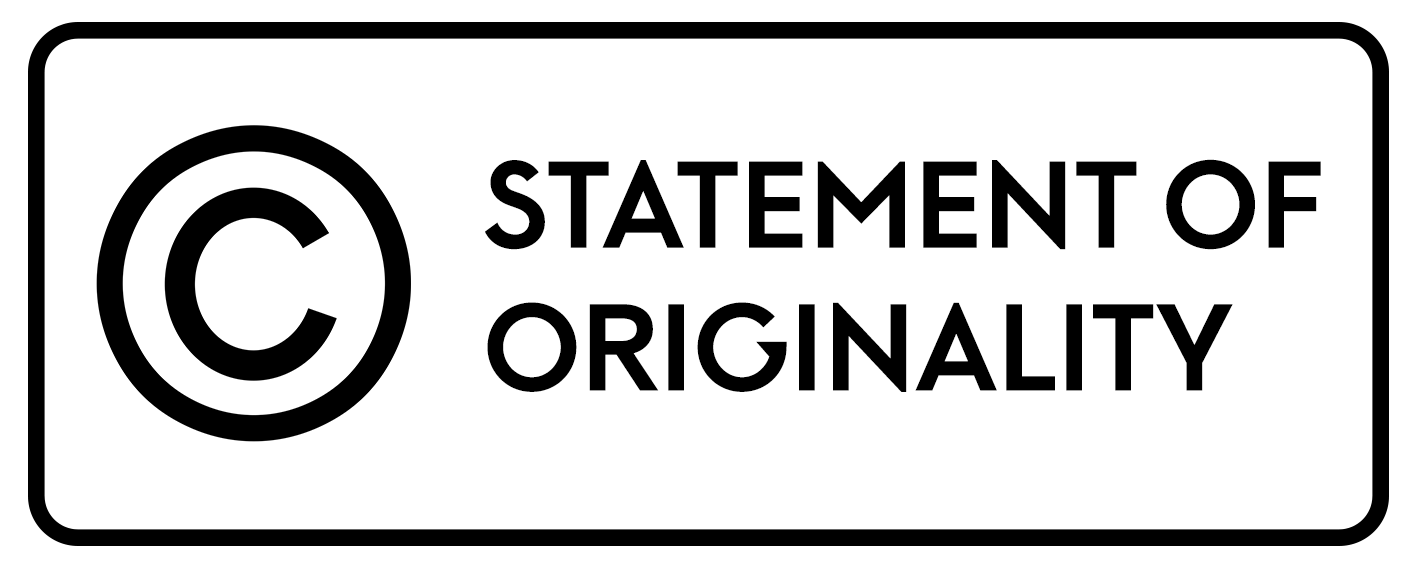Being Black and Queer in Pariah (2011) and Moonlight (2016)
Abstract
The representation of race and sexuality particularly African Americans in Hollywood has always been problematic. In its development Hollywood has been including more representations of African-Americans. With New Black Realism, which started in the midst 90s, the African-American communities change the screen with a more empowering portrayal of the community. A common theme is usually focusing on African-American youth in surviving and negotiating with the current issues concerning race. The question to be asked is to what extent do these changes actually challenge stereotypes? By analyzing two Hollywood films, Pariah (2011) and Moonlight (2016), this article looks into the representation of African American LGBTQ characters to see how the films problematize or affirm stereotypes that have been constructed by mainstream Hollywood. By analyzing narrative elements and the cinematography elements, this research reveals even though the films try to negotiate with stereotypes, they eventually affirms how stereotypes of African Americans LGBTQ are still seen in negative way.
Keywords
Full Text:
PDF (Bahasa Inggris)References
Bausch, K. (2013). Superflies into superkillers: Black masculinity in film from blaxploitation to new black realism. The Journal of Popular Culture, 46(2). Retrieved from https://onlinelibrary.wiley.com/doi/pdf/10.1111/jpcu.12025#accessDenialLayout
Bellantoni, P. (2005). If it’s purple, someone’s gonna die: the power of color in visual storytelling for film. UK: Focal Press.
Benshoff, H. M., Griffin, S. (2009). America on film: representing race, class, gender, and sexuality at the movies (2nd ed.). US: Wiley-Blackwell.
Billson, A. (2020, March 11). Where have all the black cowboys gone?. The Guardian. Retrieved from https://www.theguardian.com/film/2020/mar/11/where-have-all-the-black-cowboys-gone
Bradbury-Rance, C. (2016). Desire, outcast: locating queer adolescence. In F. Handyside & K. Taylor-Jones (Eds.), International cinema and the girl: local issues, transnational contexts (1st ed., pp. 85-96). Retrieved from https://link.springer.com/chapter/10.1057/9781137388926_7
Burn, S. M., & Ward, A. Z. (2005). Men's conformity to traditional masculinity and relationship satisfaction. Psychology of men & masculinity, 6(4), 254–263. https://doi.org/10.1037/1524-9220.6.4.254
Boyd, T. (2020, June 13). Gone with the Wind and the damaging effect of Hollywood racism. The Guardian. Retrieved from https://www.theguardian.com/film/2020/jun/13/gone-with-the-wind-hollywood-racism
Boylorn, R. M., & Hopson, M. C. (2014). Learning to conquer metaphysical dilemmas: womanist and masculinist perspective on Tyler Perry’s For Colored Girls. In Goldman, A. Y., Ford, V. S., Harris, A. A., Howard, N. R. (Eds.), Black women and popular culture: The conversation continues (1st ed., pp. 89-108). Lexington Books. Retrieved from https://books.google.co.id/books?id=zNk-BAAAQBAJ&source=gbs_navlinks_s
Carpenter, T. R. (2012). Construction of the crack mother icon. Western Journal of Black Studies, 36(4). 264-275. Retrieved from https://search.proquest.com/docview/1353494844/fulltextPDF/99809CA21E9A4B75PQ/1?accountid=17242
Chung, S. K. (2007). Media literacy art education: deconstructing lesbian and gay stereotypes in the media. The international journal of art and design education, 26(1). https://doi.org/10.1111/j.1476-8070.2007.00514.x
Ciro, A. (2019). “Homosex, hermaph, or trans-a-vest…hate fags? The answer’s yes”: hypermasculinity in America and commodified homophobia through the lens of hip hop. For(e)dialogue, 3(1). Retrieved from https://journals.le.ac.uk/ojs1/index.php/4edialog/article/view/3139/2846
Copeland, K. J. (2017). From new black realism to Tyler Perry: the characterizations of Black masculinity in Tyler Perry’s romantic storylines. Journal of Men’s Studies 2017, 25(1), 70-91. DOI: 10.1177/1060826516641096
Copeland, K. J. (2018). Moonlight, directed by Barry Jenkins. Journal of Homosexuality, 65(5), 687-689. DOI: 10.1080/00918369.2017.1333815
Curtin, N., Ward, L. M., Merriwether, A., & Caruthers, A. (2011). Femininity ideology and sexual health in young women: a focus on sexual knowledge, embodiment, and agency. International journal of sexual health, 23(1), 48-62, DOI: 10.1080/19317611.2010.524694
Daley, A., Solomon, S., Newman, P. A., & Mishna, F. (2007). Traversing the margins: Intersectionalities in the bullying of lesbian, gay, bisexual and transgender youth. Journal of gay & lesbian social services, 19(3-4), 9-29, DOI: 10.1080/10538720802161474
Diamond, L, M. (2005). ‘I’m straight, but I kissed a girl’: the trouble with American media representations of female–female sexuality. Feminism & psychology, 15(1), 104-110. DOI: 10.1177/0959-353505049712
France, L. R. (2017, February 28). Oscar mistake overshadows historic moment for 'Moonlight'. CNN. Retrieved from https://edition.cnn.com/2017/02/27/entertainment/moonlight-oscars-win/
Gault, N. A. (2019). Black masculinity in early 21st-century Hollywood cinema. [Dissertation]. Retrieved from https://search.proquest.com/docview/2384501131?pq-origsite=gscholar&fromopenview=true
Harris, A. & Mushtaq, O. (2013). Creating racial identities through film: a queer and gendered analysis of blaxploitation films. Western Journal of Black Studies, 37(1). 28-38. Retrieved from https://www.questia.com/library/journal/1G1-332655213/creating-racial-identities-through-film-a-queer-and
Hughey, M. W. (2009). Cinethetic racism: white redemption and black stereotypes in "magical negro" films. Social Problems, 56(3). 543-577. Retrieved from http://www.jstor.org/stable/10.1525/sp.2009.56.3.543
JasenkaG. (2020, Jan 19). Low key photography for beginners – enter the dark side. LightStalking. Retrieved from https://www.lightstalking.com/low-key-photography/
Jenkins, B (Director, Writer). (2016). Moonlight [Motion picture]. United States: A24
Jenkins, B. Moonlight. Retrieved from https://www.dailyscript.com/scripts/MOONLIGHT.pdf
Jones, L. (2012). Dyke/Girl: Language and Identities in a Lesbian Group. UK: Palgrave Macmillan. Retrieved from https://books.google.co.id/books?id=byL3D44NzGQC
Kannan, M., Hall, R., Hughey, M. W. (2017). Watching Moonlight in the twilight of Obama. Humanity & Society 2017, 41(3), 287-298. DOI: 10.1177/0160597617719889
Kronz, V. (2015). Women with beards and men in frocks: gender nonconformity in modern American film. Sexuality & Culture, 2016(20), 85–110. DOI: 10.1007/s12119-015-9311-4
Lawrence, N. (2016). Beyond blaxploitation. US: Wayne State University Press
Levs, J. (July, 2016). No, most black kids are not fatherless. Huffington Post. Retrieved from https://www.huffingtonpost.com/josh-levs/no-most-black-kids-are-no_b_11109876.html?ncid=engmodushpmg00000004
Missouri, M. A. (2015). Not another west side story: Nuyorican women and new black realism in I like it like that. Black magic woman and narrative film race, sex and afro-religiosity. (pp. 140-168). Retrieved from https://link.springer.com/chapter/10.1057/9781137454188_6
Media Relation Team University of Manchester. (2012). Blaxploitation birthday should mark rethink, urges historian. Retrieved from https://www.manchester.ac.uk/discover/news/blaxploitation-birthday-should-mark-rethink-urges-historian/
Montclair State University LGBTQ Center. (n.d.). Terminology. Retrieved from https://www.montclair.edu/lgbtq-center/lgbtq-resources/terminology/
Moore, M. R. (2015). Between Women TV: toward the mainstreaming of Black lesbian masculinity and Black queer women in community. Black Camera, 6(2), 201-216. Retrieved from https://www.jstor.org/stable/10.2979/blackcamera.6.2.201
National Association for the Advancement of Colored People (NAACP). (n.d.). NAACP history: Oscar Micheaux. Retrieved from https://www.naacp.org/naacp-history-oscar-micheaux/
Pasulka, N. (2016). The 'criminal' Black lesbian: where does this damaging stereotype come from?. Retrieved from https://www.npr.org/sections/codeswitch/2016/03/17/456541972/the-criminal-black-lesbian-where-does-this-damaging-stereotype-come-from
Perrin, A. (2018, March 20). "Sure, bisexual lighting looks cool - but it can be problematic". Cosmopolitan. Retrieved from https://www.cosmopolitan.com/uk/love-sex/a19491322/bisexual-lighting-problematic/
Pierpoint, G. (2018, April 22). Is 'bisexual lighting' a new cinematic phenomenon?. BBC News. Retrieved from https://www.bbc.com/news/entertainment-arts-43765856
Plummer, M. D. (2007). Sexual racism in gay communities: negotiating the ethnosexual marketplace (Dissertation). Retrieved from https://digital.lib.washington.edu/researchworks/handle/1773/9181
Raffanti M.A. (2010) LGBT-themed Hollywood cinema after Brokeback Mountain: renegotiating hegemonic representations of gay men. In Frymer B., Kashani T., Nocella A.J., Van Heertum R. (eds.), Hollywood’s exploited: public pedagogy, corporate movies, and cultural crisis (1st ed., pp. 131-148). New York, NY: Palgrave Macmillan. https://doi.org/10.1057/9780230117426_9
Rahmatiah. (2017). Identity status in Barry Jenkins’ movie “Moonlight” (Thesis). Retrieved from http://repositori.uin-alauddin.ac.id/8266/1/RAHMATIAH_.pdf
Rees, D (Director, Writer). (2011). Pariah [Motion picture]. United States: Focus Pictures.
Rees, D. Pariah. Retrieved from http://academy.filminfocus.com/scripts/pariah_screenplay.pdf
Roach, S. (2019). Unpacking Pariah: maternal figuration, erotic articulation, and the Black queer liberation plot. Signs: Journal of Women in Culture and Society 2019, 45(1), 201-225. Retrieved from https://www.journals.uchicago.edu/doi/abs/10.1086/703494
Romeo, K. E., Chico, E., Darcangelo, N., Boyd Bellinger, L., & Horn, S. S. (2017). Youth's motivations for using homophobic and misogynistic language. Journal of LGBT Youth, 14(4), 411-423. DOI: 10.1080/19361653.2017.1365036
Richardson, S. (2019, June 13). Breaking myths about black fatherhood this Father’s Day. The Chicago Reporter. Retrieved from https://www.chicagoreporter.com/breaking-myths-about-black-fatherhood-this-fathers-day/
Smelik, A. (1998). Gay and lesbian criticism. In John Hill & Pamela Gibson (Eds.), The Oxford guide to film studies (pp. 135-147). Retrieved from https://www.researchgate.net/profile/Anneke_Smelik/publication/327623558_Gay_and_Lesbian_Film_Criticism/links/5b9a3433a6fdcc59bf8e4214/Gay-and-Lesbian-Film-Criticism.pdf
Stallings, L. H. (2015). Introduction. Black Camera, 6(2), 163-167. Retrieved from https://www.jstor.org/stable/10.2979/blackcamera.6.2.163
Turner, G. (1999). Films as social practice. US: Routledge.
Tyree, T. (2011). African American stereotypes in reality television. Howard journal of communications, 22(4). 394-413. DOI: 10.1080/10646175.2011.617217
Yuen, N. W. (2010). Playing ‘ghetto’: black actors, stereotypes, and authenticity. In Hunt, D.M., Ramón A (Eds.), Black Los Angeles: American dreams and racial realities (1st ed., pp. 232-242). New York University Press. Retrieved from https://digitalcommons.biola.edu/faculty-books/107
DOI: http://dx.doi.org/10.30872/calls.v7i1.4542
Copyright (c) 2021 Shuri Mariasih Gietty Tambunan, Gertrud Nimas Cemara Tunggal

This work is licensed under a Creative Commons Attribution-ShareAlike 4.0 International License.
Editorial address:
Fakultas Ilmu Budaya, Universitas Mulawarman
Address: Jl. Ki Hajar Dewantara, Gunung Kelua, Kec. Samarinda Ulu, Kota Samarinda, Kalimantan Timur, Indonesia 75123
Email: jurnalcalls@fib.unmul.ac.id
Website: http://e-journals.unmul.ac.id/index.php/CALLS

CaLLs: Journal of Culture, Arts, Literature, and Linguistics site is licensed under a Creative Commons Attribution-ShareAlike 4.0 International License
CaLLs: Journal of Culture, Arts, Literature, and Linguistics indexing by:















